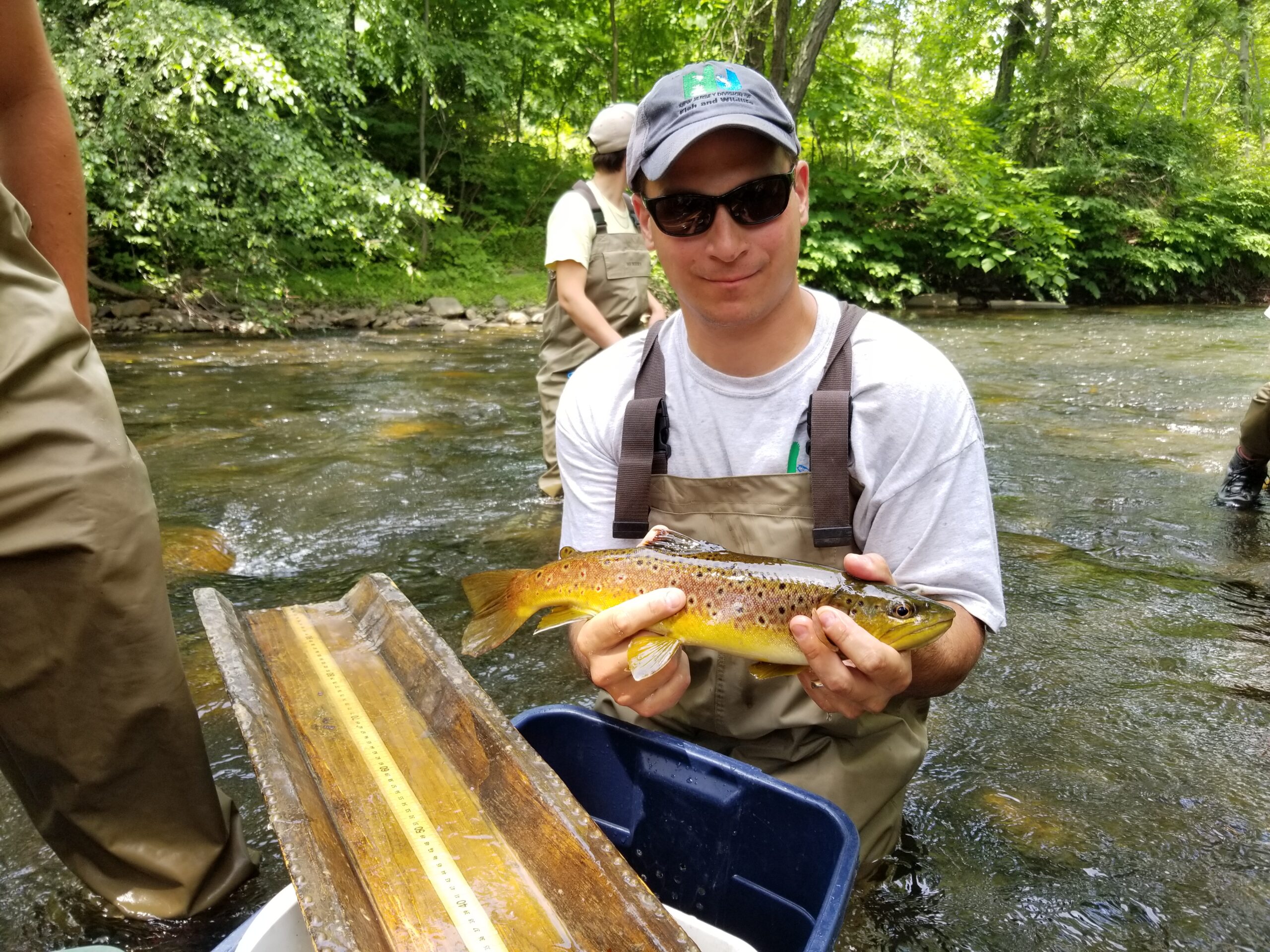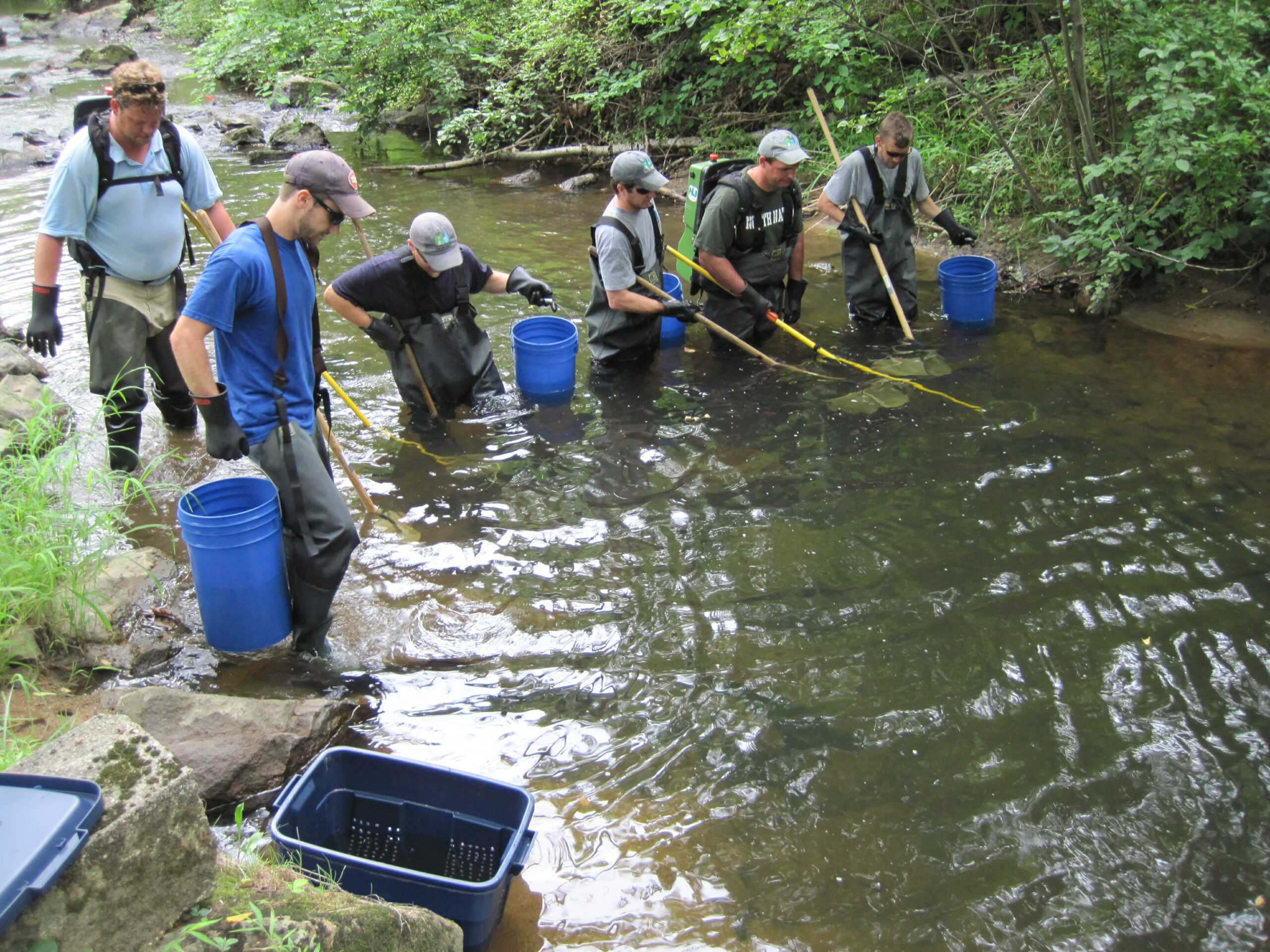New Jersey Fish and Wildlife’s Bureau of Freshwater Fisheries (BFF) is responsible for the management of New Jersey’s freshwater fisheries resources. BFF activities include many facets, including fish culture and managing wild and stocked fish populations, protecting and enhancing their habitats, and educating the public. Annually, the BFF conducts fisheries surveys to address a variety of recreational and resource management needs, including response to emerging fisheries issues. These surveys are conducted to satisfy a wide variety of projects and program needs, providing up-to-date data, so that the State’s freshwater fisheries resources, both coldwater and warmwater resources, can be properly managed. Fisheries surveys are used to monitor populations, assess stocking programs, document populations of both rare native fishes and invasive species, among a variety of other functions.
When it comes to Coldwater Fisheries Stream Surveys, the BFF focuses on a few highly important projects. One of these projects is based on the relationship of fish and their environment and aims to identify and classify streams based on water quality and critical habitat using bioindicators such as the ability of trout to naturally reproduce. Standardized stream electrofishing surveys contribute valuable data used for the classification of New Jersey’s surface waters within the Department’s Surface Water Quality Standards, N.J.A.C. 7:9B. This system is the regulatory cornerstone that helps protect critical watersheds. A variety of regulatory programs administered by NJDEP give special consideration to waters designated as trout waters. The Land Use Regulation program through its stream encroachment and freshwater wetlands permits recognize the surface water classifications for Trout Production and Trout Maintenance waters, as well as trout-stocked waters. Additional protection to these streams is afforded by minimizing project impacts through design modifications, timing restrictions, and increased buffer requirements. The Environmental Review Program staff within Fish and Wildlife review and comment on stream encroachment, freshwater wetland, and other permit applications to minimize environmental impacts to all waters of the state. The BFF collects data from electrofishing surveys to assess the current classification of the stream surveyed. These surveys provide valuable information in confirming the existing classification as well as identifying potential upgrades.

Another project on coldwater streams focuses on Trout Production streams. Trout Production streams are monitored periodically to assess the status of their naturally reproducing trout populations (every 5 years if regulated as a Wild Trout Stream, every 10 years if wild Brook Trout were historically documented, or generally once every 20 years). Surveys are conducted using established protocols, which include electrofishing a 150-m reach, physicochemical measurements, and the EPA Rapid Bioassessment for habitat (with regional modifications). The data collected through these surveys are evaluated to determine if changes have occurred and are used in the development management strategies and fishing regulations to protect this fragile resource. The data are also used by the Eastern Brook Trout Joint Venture (a National Fish Habitat Partnership) as part of a range-wide effort to conserve and manage Brook Trout in the eastern U.S.
Field Sampling Protocols- Coldwater Streams
Fish assemblages within wadeable streams can be effectively surveyed by means of electrofishing. Protocols are based from methods outlined by Kurtenbach (Kurtenbach 1994) and as defined in the EPA manual “Rapid Bioassessment Protocols for Use in Wadeable Streams and Rivers” (Barbour et al. 1999), with minor modifications. The Bureau’s stream sampling protocols are summarized below:
- Surveys are conducted during the summer months (July through mid- September), under typical flow conditions.
- Site must be wadeable and representative of greater stream segment.
- Survey should end at a barrier to fish movement or at an installed block net.
- Electrofishing gear and number of personnel used are commensurate with stream width.
- A measured distance of 150 m is electrofished with a single pass using one or more backpack electrofishers or a generator positioned on land, or in a barge, with 2-3 hand-held anodes.
- Every fish >20 mm should be netted and identified to the species level.
- Total length to the nearest mm is measured for all sport fish.
- Voucher specimens are retained for laboratory identification when necessary.
- All fish are inspected for D.E.L.T. anomalies (Deformity, Erosion of fins, Lesions, and Tumors).
- Physicochemical parameters (air and water temperature, dissolved oxygen, pH, conductance/specific conductance, total dissolved solids, salinity, stream width and depth, substrate, and canopy cover are measured or estimated.
- An assessment of instream and riparian habitat is conducted using the EPA Rapid Bioassessment habitat assessment protocol (with regional modifications).
LITERATURE CITED
Barbour, M. T., J. Gerritsen, B. D. Snyder and J. B. Stribling. 1999. Rapid bioassessment protocols for use in streams and wadeable rivers: periphyton, benthic macroinvertebrates, and fish, 2nd edition. EPA 841-B-99-002. U. S. Environmental Protection Agency, Office of Water, Washington, D.C.
Kurtenbach, J. 1994. Index of biotic integrity study – New Jersey – Passaic, Wallkill, Delaware, and Raritan drainages, summer (1990-1993): U.S. Environmental Protection Agency, 32pp. Plus appendices.
 Official Site of The State of New Jersey
Official Site of The State of New Jersey


